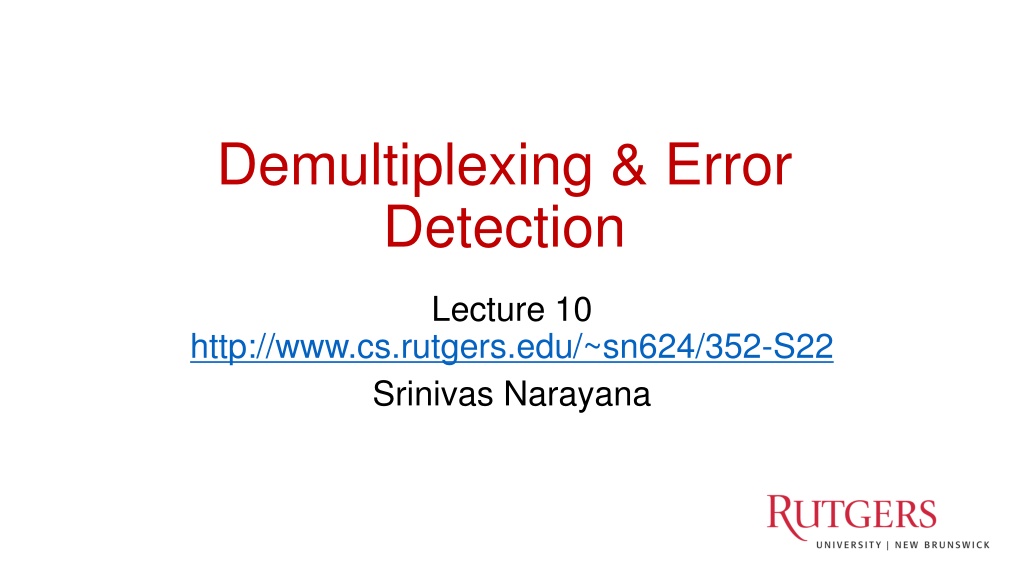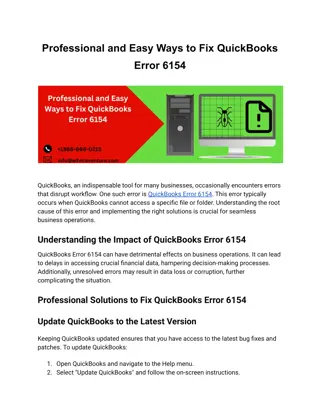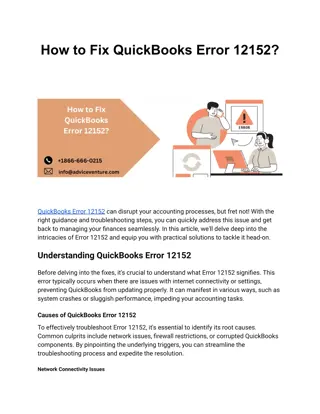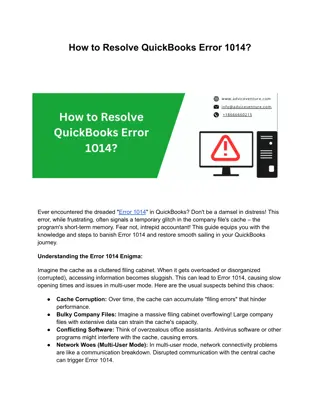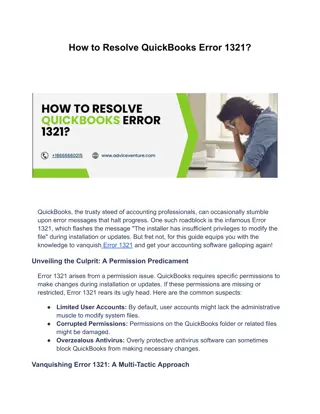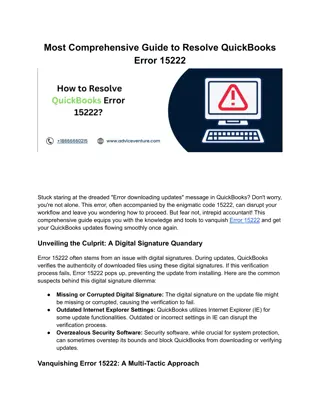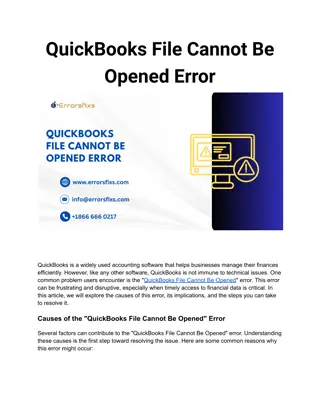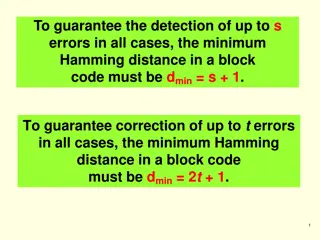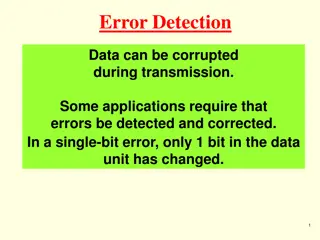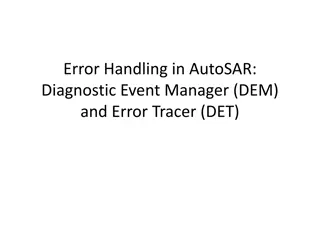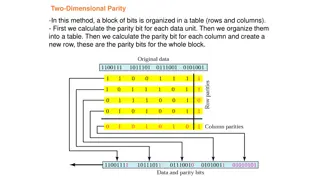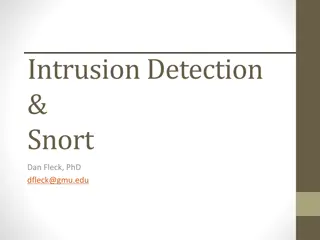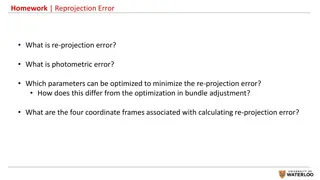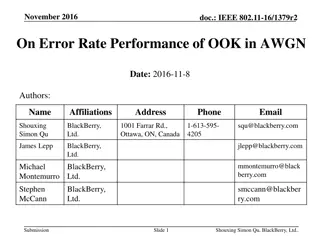Demultiplexing & Error Detection
This lecture delves into demultiplexing and error detection within the network layers, emphasizing the concepts of TCP, UDP, varying quality streaming over HTTP, and the role of CDNs. It discusses the different ports and IP addresses involved in demultiplexing packets, highlighting their attachment points within the network structure. The connection lookup process undertaken by the operating system to match sockets with applications is also explored, offering insights into the functioning of TCP sockets and socket IDs.
Uploaded on Feb 23, 2025 | 0 Views
Download Presentation

Please find below an Image/Link to download the presentation.
The content on the website is provided AS IS for your information and personal use only. It may not be sold, licensed, or shared on other websites without obtaining consent from the author.If you encounter any issues during the download, it is possible that the publisher has removed the file from their server.
You are allowed to download the files provided on this website for personal or commercial use, subject to the condition that they are used lawfully. All files are the property of their respective owners.
The content on the website is provided AS IS for your information and personal use only. It may not be sold, licensed, or shared on other websites without obtaining consent from the author.
E N D
Presentation Transcript
Demultiplexing & Error Detection Lecture 10 http://www.cs.rutgers.edu/~sn624/352-S22 Srinivas Narayana 1
Quick recap of concepts DASH Video streaming over HTTP Varying quality, varying sources, over the duration of the video Can use CDNs! TCP UDP Transport layer Endpoint Endpoint Network layer
Demultiplexing Port 1 Machine 1 IP addr 1 Applications Port 2 Denotes an attachment point with the network. Transport Machine 1 Network Port 65535 Machine 1 IP addr 2 Link layer Ports Each IP address comes with a full copy of its own ports. socket() Machine
Demultiplexing Port 1 Machine 1 IP addr 1 Port 2 Denotes an attachment point with the network. Transport Machine 1 Network Port 65535 Machine 1 IP addr 2 Ports Each IP address comes with a full copy of its own ports. socket() Machine
Demultiplexing Port 1 Machine 1 IP addr 1 Port 2 Denotes an attachment point with the network. Src port, Dst port Machine 1 Src IP, Dst IP, Tp Protocol Port 65535 Machine 1 IP addr 2 Ports Each IP address comes with a full copy of its own ports. socket() Machine
Connection lookup: The operating system does a lookup using these data to determine the right socket and app. Demultiplexing Port 1 Machine 1 IP addr 1 Port 2 Denotes an attachment point with the network. Src port, Dst port Machine 1 Src IP, Dst IP, Tp Protocol Port 65535 Machine 1 IP addr 2 Ports Each IP address comes with a full copy of its own ports. socket() Machine
Connection lookup: The operating system does a lookup using these data to determine the right socket and app. TCP sockets: (src IP, dst IP, src port, dst port) Socket ID Demultiplexing Port 1 Machine 1 IP addr 1 Port 2 Denotes an attachment point with the network. Machine 1 Port 65535 Machine 1 IP addr 2 Ports Each IP address comes with a full copy of its own ports. socket() Machine
Connection lookup: The operating system does a lookup using these data to determine the right socket and app. TCP sockets: (src IP, dst IP, src port, dst port) Socket ID Demultiplexing Port 1 Machine 1 IP addr 1 Port 2 Denotes an attachment point with the network. Machine 1 Port 44262 Port 65535 Machine 1 IP addr 2 Ports Each IP address comes with a full copy of its own ports. socket() Machine
Connection lookup: The operating system does a lookup using these data to determine the right socket and app. TCP sockets: (src IP, dst IP, src port, dst port) Socket ID Demultiplexing Port 1 Machine 1 IP addr 1 Port 2 Denotes an attachment point with the network. Machine 1 Port 65535 Machine 1 IP addr 2 UDP sockets: (dst IP, dst port) Socket ID Connectionless: the socket is shared across all sources! Ports Each IP address comes with a full copy of its own ports. socket() Machine
Connection lookup: The operating system does a lookup using these data to determine the right socket and app. TCP sockets** Some caveats! (src IP, dst IP, src port, dst port) Socket ID Demultiplexing Port 1 Machine 1 IP addr 1 Port 2 Denotes an attachment point with the network. Machine 1 Port 65535 Machine 1 IP addr 2 UDP sockets: (dst IP, dst port) Socket ID Connectionless: the socket is shared across all sources! Ports Each IP address comes with a full copy of its own ports. socket() Machine
TCP sockets of different types Listening (bound but unconnected) Connected (Established) # On server side csockid, addr = ss.accept() # On server side ss = socket(AF_INET, SOCK_STREAM) # On client side ss.bind(serv_ip, serv_port) cs.connect(serv_ip, serv_port) ss.listen() # no accept() yet (src IP, dst IP, src port, dst port) Socket(csockid NOT ss)
TCP sockets of different types Listening (bound but unconnected) Connected (Established) accept() creates a new socket with the 4-tuple (established) mapping # On server side csockid, addr = ss.accept() # On server side ss = socket(AF_INET, SOCK_STREAM) # On client side ss.bind(serv_ip, serv_port) cs.connect(serv_ip, serv_port) ss.listen() # no accept() yet (dst IP, dst port) Socket (ss) Enables new connections to be demultiplexed correctly (src IP, dst IP, src port, dst port) Socket(csockid NOT ss) Enables existing connections to be demultiplexed correctly
TCP demultiplexing When a TCP packet comes in, the operating system: Looks up table of existing connections using 4-tuple If success, send to corresponding (established) socket If fail (no table entry), look up table of listening connections using just (dst IP, dst port) If success, send to corresponding (listening) socket If fail again (no table entry), send error to client Connection refused
UDP demultiplexing When a UDP packet comes in, the operating system: Looks up table of listening UDP sockets using (dst IP, dst port) If success, send packet to corresponding socket There are no established UDP sockets; they re all unconnected If fail (no table entry), send error to client Port unreachable
Listing sockets and connections List all sockets with ss Create and observe UDP sockets with iperf Observe a TCP listening socket with iperf (or your own server!)
UDP: User Datagram Protocol [RFC 768] Best effort service. UDP segments may be: Lost Delivered out of order to app UDP is connectionless Each UDP segment handled independently of others (i.e. no memory across packets) Suitable for one-off req/resp E.g., DNS uses UDP Also for loss-tolerant delay- sensitive apps, e.g., video calling Why are UDP s guarantees even okay? Simple & low overhead compared to TCP: No delays due to connection establishment UDP can send data immediately No memory for connection state at sender & receiver Small segment header UDP can blast away data as fast as desired UDP has no congestion control
Length of segment UDP segment structure (UDP header + data) Error detection info (more to come) Applications 16 bits 16 bits source port # dest port # Transport checksum length Network application data (message) Link layer
UDP segment structure Source IP address Destination IP address Applications source port # dest port # Transport checksum length Network application data (message) Link layer
Review: UDP demultiplexing Source IP address Destination IP address Port 1 Machine 1 IP 1 Port 2 source port # dest port # checksum length Machine 1 Port 44262 Port 65535 application data (message) Machine 1 IP 2 Ports socket()
Seeing UDP packets in action How to craft and send (UDP) packets? It s simpler than you think! sudo tcpdump -i lo udp XAvvv # observe packets sudo scapy # tool used to send crafted packets Example: send(IP(dst="127.0.0.1")/UDP(sport=1024, dport=2048)/"hello world , iface="lo") See other fields of UDP using UDP().fields_desc Scapy can send and receive crafted packets! However, it requires sudo (superuser privileges)
Why error detection? Network provides best effort service UDP is a simple and low overhead transport Data may be lost Data may be corrupted along the way (e.g., 1 -> 0) Data may be reordered However, simple error detection is possible! Was the data I received the same data the remote machine sent? Error detection is a useful feature for all transport protocols including TCP
Error Detection in UDP and TCP Key idea: have sender compute a function over the data Store the result in the packet Receiver can check the function s value in received packet An analogy: you re sending a package of goodies and want your recipient to know if goodies were leaked along the way Your idea: weigh the package; stamp the weight on the package Have the recipient weigh the package and cross-check the weight with the stamped value
Requirements on error detection function Function must be easy to compute Function must capture the likely changes to the packet If the packet was corrupted through these likely changes, the function value must change Function must be easy to verify UDP and TCP use a class of function called a checksum Very common idea: used in multiple parts of networks and computer systems
UDP & TCPs Checksum function Sender: treat segment contents as sequence of 16-bit integers checksum: addition (1 s complement sum) of segment contents sender puts checksum value into UDP checksum field Receiver: compute a checksum of the received segment, including the checksum in packet itself check if the resulting (computed) checksum is 0 NO an error is detected YES assume no error
Computing 1s complement sum Very similar to regular (unsigned) binary addition. However, when adding numbers, a carryout from the most significant bit needs to be added to the result Example: add two 16-bit integers 1 1 1 1 0 0 1 1 0 0 1 1 0 0 1 1 0 1 1 1 0 1 0 1 0 1 0 1 0 1 0 1 0 1 wraparound 1 1 0 1 1 1 0 1 1 1 0 1 1 1 0 1 1 sum 1 1 0 1 1 1 0 1 1 1 0 1 1 1 1 0 0 1 0 1 0 0 0 1 0 0 0 1 0 0 0 0 1 1 checksum 28
From the UDP specification (RFC 768) Checksum is the 16-bit one's complement of the one's complement sum of a pseudo header of information from the IP header, the UDP header, and the data, padded with zero octets at the end (if necessary) to make a multiple of two octets. The pseudo header conceptually prefixed to the UDP header contains the source address, the destination address, the protocol, and the UDP length.
Some observations on checksums Checksums don t detect all bit errors Consider (x, y) vs. (x 1, y + 1) as adjacent 16-bit values in packet Analogy: you can t assume the package hasn t been meddled with if its weight matches the one on the stamp. More smarts needed for that. But it s a lightweight method that works well in many cases Checksums are part of the packet; they can get corrupted too The receiver will just declare an error if it finds an error However, checksums don t enable the receiver to detect where the error lies or correct the error(s) Checksum is an error detection mechanism; not a correction mechanism.
Some observations on checksums Checksums are insufficient for reliable data delivery If a packet is lost, so is its checksum UDP and TCP use the same checksum function TCP also uses the lightweight error detection capability However, TCP has more mature mechanisms for reliable data delivery (more to come on this)
Summary of UDP UDP is a thin shim around network layer s best-effort delivery One-off request/response messages Lightweight transport for loss-tolerant delay-sensitive applications Provides basic multiplexing/demultiplexing for application No reliability, performance, or ordering guarantees Can do basic error detection (bit flips) using checksums Error detection is necessary to deliver data reliably, but it is insufficient
